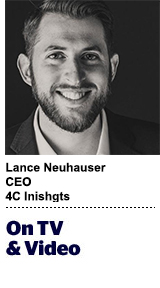 “On TV And Video” is a column exploring opportunities and challenges in advanced TV and video.
“On TV And Video” is a column exploring opportunities and challenges in advanced TV and video.
Today’s column is written by Lance Neuhauser, CEO at 4C Insights.
We’re about to witness a generational realignment of the media mix. Consumers have complete control over how they receive information, and they can subscribe, fast-forward, opt out, block or simply turn their attention to a different screen any time they don’t want to see something.
This has left the advertising industry squeezed. Brands are squeezed by complexity and competition. Agencies, tasked with solving for these complexities in brand-safe ways, are squeezed by trying to do much more with a lot less. Publishers are getting squeezed on pricing and margins due to fragmented audiences and the inability to attribute sales that resulted from their offerings.
This new reality has kicked up the proverbial dust around decades-old media models and budgets, particularly the billions of brand advertising dollars that still go predominantly to linear television. As that settles over the next few years, those budgets will undoubtedly still go to video, which is what will be left after digital video, on-demand video, over-the-top (OTT) and linear complete their inevitable convergence. Roughly half of total global ad spend is up for grabs.
Many players could capitalize on this sea change. Given the current regulatory landscape for marketers and ad tech vendors, it’s quite unlikely that the open web will make a serious play for these upper-funnel dollars. Rather, they’ll likely find their way into private marketplaces, which are better positioned to obtain user opt-ins to drive their data engines.
But which will present the most fertile territory for marketers’ upper-funnel seeds?
The duopoly’s bid for dominance
Both Google and Facebook are at varying stages of making their bid for the money that’s been knocked loose by the media-mix realignment. Long-established YouTube viewership helps put Google ahead of the game, but only by a step. Despite its efforts, the platform still has a long way to go as a definitive destination for video consumption beyond the short form. But given YouTube has been trying to position itself as a competitor to TV for years now, it already has learnings under its belt that others do not.
Meanwhile, Facebook’s bid for TV dollars is more in its infancy with the Facebook Watch platform. Facebook has the audience but isn’t yet a true viewing destination for long-form content. However, with Facebook outwardly investing in unique content, evidenced in its recently confirmed plan to create a news section within Watch, the platform – or some future iteration of it – remains a serious contender.
But this battle is far from over, and the next three years represent an incredible opportunity for other platforms to capitalize on the convergence of TV and video.
Enter the smaller gardens
We’ve arrived at a unique moment in time for Snap, Pinterest and Twitter. When it comes to the convergence of TV and video, everyone – even the duopoly – qualifies as a new player. The smaller players have just as much of an opportunity to grab market share in the evolving media landscape as do Google and Facebook.
Snap, Pinterest, Twitter and LinkedIn benefit from their established audiences, but they have to date failed to deliver industry-redefining products worthy of TV-level dollars. If they don’t make their moves soon, the opportunity to do so will pass them by.
Snap represents an interesting player to watch. If the platform continues to produce the creative innovation that has impressed brands to date, Snap has a strong chance of assuming new stature in the media-mix realignment, particularly if it focuses on becoming the next generation of television.
That said, if we consider Google and Facebook when they were at the same point as Snap on its trajectory, neither would be the companies we know today without M&A activity. Google wouldn’t be Google without YouTube, DoubleClick and Android. Facebook wouldn’t be Facebook without Instagram, WhatsApp and even Oculus.
For Snap, we’re at a critical time where the company can no longer focus just on ad tech. The company must kick up its M&A activity and evolve its user experience in a way that dramatically distinguishes Snap from others. If it can evolve and put the right measurement underpinnings in place, Snap could very well emerge as a formidable player in the marketplace. But there’s no shortage of work to be done.
This opportunity for Snap and smaller gardens is just as real for OTT players, such as Amazon, and traditional TV providers. All of them face the squeeze. Their prospects would take another op-ed, or two, to properly examine. Stay tuned.
Challenger players, like Snap and others, have a real shot to nail the convergence of media and enter the fray of the larger players, capturing the billions in spend that will be on the move. But the clock is ticking. Dominoes have begun to fall, and the media mix is in flux. When media dollars are up for grabs, players need to grab them quickly – or they might be gone for a very long time.
Follow Lance Neuhauser (@LanceNeuhauser), 4C (@4Cinsights) and AdExchanger (@adexchanger) on Twitter.
This post was syndicated from Ad Exchanger.

More Stories
NZME celebrates 2024 Voyager Media Awards nominations
Squeezing Innovation: CEO Monica McGurk’s Fresh Take at Tropicana
How This Kid-Focused Media Company Balances Privacy And Ad Measurement